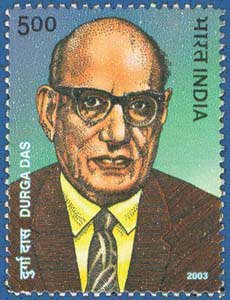Durga Das (1900-1974)

Technical Data
| Date of Issue | May 2, 2003 |
|---|---|
| Quantity | 400,000 |
| Perforation | comb 13 |
| Printer | Security Printing Press, Nashik |
| Watermark | No Watermark |
| Colors | Multicolor |
| Catalog Codes |
Michel IN 1958 Stamp Number IN 2003 Yvert et Tellier IN 1723 Stanley Gibbons IN 2128 WADP Numbering System - WNS IN015.03 |
| Themes | Authors | Commemoration | Famous people | Journalists | Literary People (Poets and Writers) | Literature | Men | Optical Instruments |
Table of Contents
Commemorative Stamp Set: Durga Das (1900–1974)
Design Elements:
- Central Image: A portrait of Durga Das, depicted in a contemplative pose, symbolizing his journalistic intellect and contribution.
- Newspaper and Pen Motif: Background elements include a vintage newspaper and a fountain pen, representing his decades of service to journalism.
- Text: His name “Durga Das” and the years “1900-1974” are displayed prominently, with inscriptions highlighting his roles such as “Chief Editor” and “Political Columnist.”
- Background: A subtle overlay of the Indian Parliament building, symbolizing his significant presence as a Chief Parliamentary Correspondent.
- Border: Decorated with patterns inspired by vintage typewriters, symbolizing the era of print journalism.
Cultural and Historical Significance:
- Journalistic Legacy: Durga Das was a pioneering journalist who played a crucial role in documenting India’s national movement and post-independence politics.
- National Service: His journalism was not only a career but a way to serve the nation, providing an objective voice during a time of great political change.
- Historical Influence: As a Chief Editor, parliamentary correspondent, and founder of The India News and Feature Alliance, his work influenced public opinion and government policy during pivotal moments in Indian history.
Usage:
- Issued to Celebrate: The lasting impact of Durga Das on Indian journalism and his dedication to the national cause through his profession.
- Special Edition: Part of a series recognizing influential Indian journalists who contributed to the freedom movement and post-independence nation-building.
- Postage: Used for commemorative and cultural mail, promoting awareness of Indian journalistic history and contributions to democracy.
Importance of the Commemorative Stamp Set:
- Recognition of Journalistic Integrity: Highlights the importance of press freedom, fair reporting, and the role of journalists in shaping modern India.
- Educational Value: Introduces new generations to the contributions of Durga Das, showcasing the power of responsible journalism.
- Cultural Contribution: Honors the role of the media in India’s political and social progress, particularly in the early years of independence.
Example of the Stamp Design:
A close-up of Durga Das, captured mid-thought, surrounded by symbolic elements like a typewriter and the Indian Parliament, with a background in soft tones evoking the vintage aesthetics of his journalistic era. The stamp design could also feature excerpts from his famous writings, such as “India from Curzon to Nehru & After,” inscribed lightly in the background.
The Commemorative Stamp Set Might Include:
- Durga Das: The central figure, emphasizing his legacy in journalism.
- Fellow Journalists: Other prominent journalists like Kuldip Nayar or C.Y. Chintamani could be included in the series, creating a tribute to Indian journalism.
Significance:
- Celebration of Press Freedom: Reinforces the importance of a free press in a democracy, recognizing the critical role played by journalists like Durga Das.
- Public Awareness: Raises consciousness about journalistic ethics and the contributions of media professionals to India’s national narrative.
